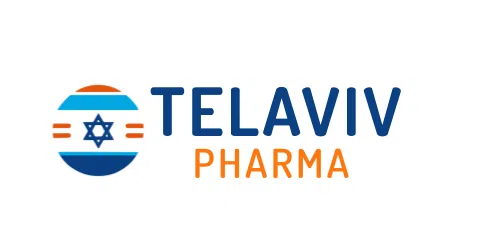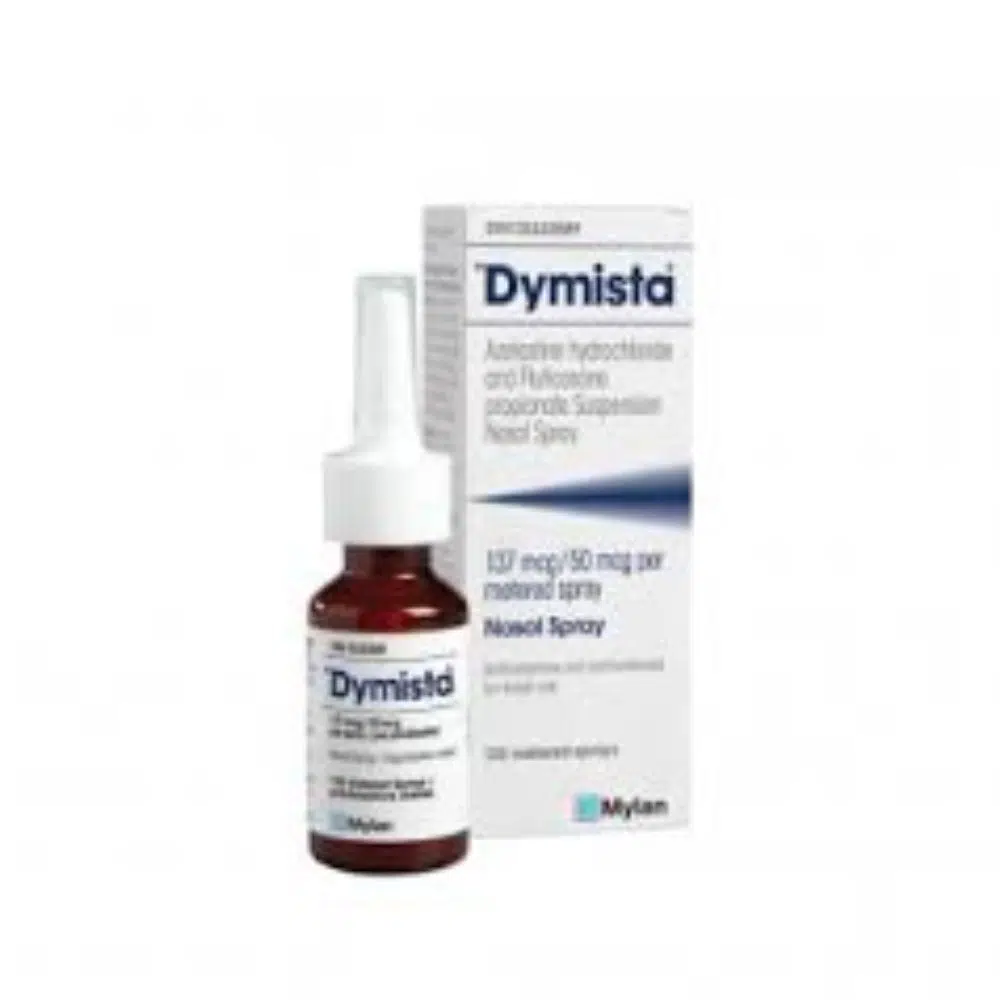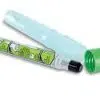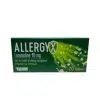No products in the cart.
Return To ShopDymista
Dymista is a dual-action nasal spray containing azelastine hydrochloride (antihistamine) and fluticasone propionate (corticosteroid) for treating moderate to severe allergic rhinitis. This combination medication provides superior symptom relief when single-agent therapy proves insufficient, addressing both immediate allergic responses and underlying inflammation. For patients seeking affordable allergy medications, working with healthcare providers ensures proper diagnosis and access to effective treatments that can significantly improve quality of life during allergy seasons and year-round exposure to allergens.
- Prescription Required
| Brand | Form | Price | Qty | Action |
|---|---|---|---|---|
| Dymista Nasal Spray Brand | 137/50mcg 120 Doses | $84.00 |
- Please note all prices are in US dollars
Dymista nasal spray represents an advanced therapeutic approach to allergic rhinitis management, combining two distinct mechanisms of action in a single convenient formulation. The medication contains azelastine hydrochloride (137 micrograms per spray) and fluticasone propionate (50 micrograms per spray), delivering both rapid symptom relief and sustained anti-inflammatory protection against allergic responses.
Azelastine hydrochloride functions as a selective H1-receptor antagonist and mast cell stabilizer, providing immediate blockade of histamine-mediated allergic reactions. This antihistamine component begins working within minutes of administration, rapidly reducing symptoms like runny nose, sneezing, and nasal itching. Unlike many oral antihistamines, topical azelastine delivers concentrated medication directly to affected nasal tissues while minimizing systemic side effects.
Fluticasone propionate serves as a potent synthetic corticosteroid with high topical anti-inflammatory activity and minimal systemic absorption when used intranasally. This component addresses the underlying inflammatory cascade that perpetuates allergic rhinitis symptoms, reducing mucosal swelling, mucus production, and inflammatory cell infiltration. The corticosteroid effect builds over several days to weeks, providing sustained symptom control and preventing allergic sensitization progression.
Clinical Superiority of Combination Therapy: The dual-mechanism approach of Dymista addresses both immediate and delayed-phase allergic reactions more effectively than monotherapy with either component alone. Clinical studies demonstrate superior efficacy in controlling nasal congestion, rhinorrhea, sneezing, and nasal itching compared to individual antihistamine or corticosteroid treatments. This combination is particularly beneficial for patients with moderate to severe allergic rhinitis who experience inadequate symptom control with single-agent therapy.
For patients managing seasonal allergies or perennial rhinitis, Dymista offers the convenience of twice-daily dosing with sustained 12-hour symptom relief. The medication addresses multiple allergen triggers including pollen, dust mites, pet dander, and mold spores, making it suitable for both seasonal hayfever and year-round allergic rhinitis management.
Pharmacokinetic Advantages: The intranasal delivery system ensures high local concentrations of active ingredients at the site of allergic inflammation while maintaining low systemic bioavailability. Azelastine achieves peak nasal tissue concentrations within 2-3 hours, while fluticasone demonstrates sustained local activity with minimal absorption into systemic circulation. This targeted delivery maximizes therapeutic benefits while reducing the risk of systemic side effects associated with oral medications.
Formulation and Administration Considerations: Dymista utilizes a specialized suspension formulation that maintains drug stability and ensures consistent dosing throughout the product’s shelf life. The medication contains benzalkonium chloride as a preservative, which may cause mild nasal irritation in sensitive individuals but also enhances drug penetration through nasal mucosa. Proper administration technique, including gentle shaking before use and avoiding head tilting backward after spraying, ensures optimal drug delivery and minimizes unpleasant taste sensations.
Long-term Safety and Efficacy: Dymista has been studied for extended use in managing chronic allergic rhinitis, demonstrating maintained efficacy without significant tolerance development. The low systemic absorption of both components makes it suitable for long-term therapy in appropriate patients, though regular monitoring is recommended for pediatric patients to assess growth parameters and in adults with risk factors for corticosteroid-related complications.
For patients exploring comprehensive allergy management, Dymista represents an excellent option when combined with environmental control measures and trigger avoidance. Those using multiple respiratory medications should coordinate timing to maximize effectiveness. Patients seeking cost-effective allergy treatment options should work with healthcare providers to determine if combination therapy provides better value than separate medications. The medication requires proper technique and consistent use for optimal results, and patients should understand that while Dymista provides excellent symptom control, it works best as part of a comprehensive allergy management strategy that includes environmental controls and lifestyle modifications when possible.
| Brand | Dymista Nasal Spray Brand |
|---|---|
| Form | 137/50mcg 120 Doses |
Dymista can cause various side effects ranging from common local nasal reactions to rare systemic effects. Most side effects are mild and related to the nasal application site, though some patients may experience more significant reactions requiring medical attention.
Very Common Side Effects (>10% of patients):
- Nosebleed (epistaxis): Most frequent side effect, usually mild and self-limiting
- Nasal irritation: Mild stinging, burning, or discomfort immediately after application
Common Side Effects (1-10% of patients):
- Headache: Usually mild to moderate intensity
- Bitter taste: Unpleasant metallic or medicinal taste, especially when tilting head backward
- Unpleasant smell: Altered sense of smell or medicinal odor perception
- Nasal dryness: Reduced nasal moisture and potential crusting
- Throat irritation: Scratchy or dry throat sensation
Uncommon Side Effects (0.1-1% of patients):
- Nasal irritation symptoms: Mild stinging, itching, or sneezing after application
- Cough: Dry or irritative cough from post-nasal drip
- Dry throat: Throat dryness and discomfort
- Nasal congestion: Paradoxical worsening of stuffiness (rare)
Rare Side Effects (0.01-0.1% of patients):
- Dry mouth: Reduced saliva production
- Nasal crusting: Formation of dried secretions in nasal passages
- Altered taste sensation: Changes in taste perception beyond bitter taste
Very Rare Side Effects (<0.01% of patients):
- Dizziness or drowsiness: Mild sedation or balance disturbances
- Fatigue: Unusual tiredness or weakness
- Skin reactions: Rash, itching, or hives
- Bronchospasm: Airway constriction in susceptible individuals
Serious Ocular Side Effects (Very Rare):
- Cataract formation: Lens clouding with prolonged high-dose use
- Glaucoma: Increased eye pressure potentially leading to vision loss
- Blurred vision: Visual disturbances or decreased visual acuity
- Eye pain: Discomfort or pressure sensation in eyes
Nasal and Respiratory Complications:
- Nasal septal perforation: Rare but serious erosion through nasal septum
- Nasal sores: Ulceration or erosion of nasal mucosa
- Secondary infections: Bacterial or fungal overgrowth
- Mucous membrane damage: Tissue breakdown from prolonged use
Allergic and Hypersensitivity Reactions:
- Mild allergic reactions: Local swelling, redness, or itching
- Contact dermatitis: Skin inflammation around application area
- Severe allergic reactions (extremely rare): Anaphylaxis with facial swelling, difficulty breathing
- Angioedema: Swelling of face, lips, tongue, or throat
Systemic Corticosteroid Effects (Long-term High-dose Use):
- Adrenal suppression: Reduced natural hormone production
- Growth retardation: Slowed growth in children and adolescents
- Bone density reduction: Osteoporosis risk with prolonged use
- Immune suppression: Increased infection susceptibility
- Weight changes: Potential weight gain or loss
- Mood changes: Depression, anxiety, or mood swings
Endocrine and Metabolic Effects:
- Hypothalamic-pituitary-adrenal axis suppression: Disrupted stress response
- Cushingoid features: Moon face, central obesity (very rare)
- Blood sugar elevation: Hyperglycemia in susceptible patients
- Electrolyte imbalances: Sodium retention, potassium loss
Age-Related Considerations:
- Pediatric patients: Higher risk of growth suppression and systemic effects
- Elderly patients: Increased sensitivity to corticosteroid effects
- Adolescents: Particular monitoring needed for growth velocity
Drug Interaction-Related Side Effects:
- Enhanced corticosteroid effects: With CYP3A4 inhibitors (ketoconazole, ritonavir)
- Increased systemic exposure: Higher risk of systemic side effects
- Sedation enhancement: Increased drowsiness with CNS depressants
Administration-Related Side Effects:
- Incorrect technique effects: Reduced efficacy, increased side effects
- Over-dosing consequences: Enhanced local and systemic effects
- Contamination risks: Infection from improper storage or use
Warning Signs Requiring Immediate Medical Attention:
- Severe allergic reactions: Difficulty breathing, facial swelling, severe rash
- Vision problems: Sudden vision loss, severe eye pain, rainbow halos
- Persistent nosebleeds: Heavy or frequent bleeding episodes
- Signs of infection: Fever, purulent nasal discharge, worsening symptoms
- Severe nasal damage: Persistent pain, crusting, or unusual discharge
Long-term Monitoring Requirements:
- Pediatric growth assessment: Height measurements every 3-6 months
- Ocular examinations: Annual eye exams for cataract and glaucoma screening
- Nasal examination: Regular assessment for mucosal damage
- Adrenal function testing: If systemic effects suspected
Prevention and Management Strategies:
- Proper administration technique: Reduces most local side effects
- Lowest effective dose: Minimizes systemic exposure risks
- Regular medical monitoring: Early detection of complications
- Patient education: Recognition of warning signs and proper use
Critical Safety Note: While most side effects are mild and manageable, patients should be aware that prolonged use of corticosteroid-containing nasal sprays can cause serious systemic effects, particularly in children. Regular medical supervision is essential for safe long-term use.
Dymista (azelastine hydrochloride/fluticasone propionate) nasal spray has specific regulatory approvals for treating allergic rhinitis when monotherapy proves insufficient, based on extensive clinical research demonstrating superior efficacy of combination therapy over individual components:
Primary Indication:
Moderate to Severe Allergic Rhinitis:
- Seasonal allergic rhinitis (hay fever): Reactions to tree, grass, and weed pollens during specific seasons
- Perennial allergic rhinitis: Year-round allergies to dust mites, pet dander, mold spores, and environmental allergens
- Mixed allergic rhinitis: Combination of seasonal and perennial allergen sensitivities
- Occupational allergic rhinitis: Workplace allergen exposure causing persistent symptoms
Specific Clinical Criteria for Dymista Use:
- Inadequate monotherapy response: Insufficient symptom control with antihistamine alone
- Insufficient corticosteroid efficacy: Incomplete symptom relief with intranasal corticosteroid monotherapy
- Multiple symptom complexity: Patients requiring both immediate and sustained symptom relief
- Quality of life impairment: Significant functional limitation from allergic rhinitis symptoms
Clinical Study Evidence:
Efficacy Endpoints Demonstrated:
- Nasal symptom score reduction: Superior improvement in total nasal symptom scores compared to placebo and monotherapy
- Individual symptom relief: Significant reduction in nasal congestion, rhinorrhea, sneezing, and nasal pruritus
- Quality of life improvement: Enhanced sleep quality, daily functioning, and overall well-being measures
- Onset of action: Rapid symptom relief beginning within 30 minutes of first dose
- Sustained efficacy: Maintained symptom control with twice-daily dosing throughout treatment periods
Comparative Effectiveness Studies:
- Versus azelastine monotherapy: Superior nasal congestion relief and overall symptom control
- Versus fluticasone monotherapy: Faster onset of action and enhanced antihistamine effects
- Versus oral antihistamines: Better nasal congestion relief and fewer systemic side effects
- Versus placebo: Statistically significant and clinically meaningful symptom improvement
Dosing and Administration Protocol:
Standard Dosing Regimen:
- Adults and adolescents ≥12 years: One spray per nostril twice daily (morning and evening)
- Total daily dose: 274 micrograms azelastine + 100 micrograms fluticasone
- Maximum recommended duration: Seasonal use for pollen allergies, continuous use for perennial rhinitis
- Not recommended: Children under 12 years of age
Proper Administration Technique:
- Preparation: Shake bottle gently for 5 seconds before each use
- Priming: Initial priming requires 6 actuations; re-prime with 1 actuation if unused >7 days
- Positioning: Keep head tilted downward, not backward, during and after administration
- Application: Insert spray tip into nostril, close opposite nostril, spray once while breathing in gently
- Post-administration: Breathe through mouth, avoid tilting head backward to prevent throat drainage
Patient Selection and Clinical Assessment:
Ideal Candidates for Dymista:
- Moderate to severe symptoms: Significant impact on daily activities, sleep, or quality of life
- Polysymptomatic presentation: Multiple nasal symptoms requiring comprehensive management
- Monotherapy failures: Inadequate response to single-agent antihistamine or corticosteroid therapy
- Rapid relief requirements: Need for both immediate and sustained symptom control
- Compliance capabilities: Able to maintain twice-daily dosing regimen
Clinical Assessment Requirements:
- Symptom severity scoring: Documentation of baseline nasal symptom scores
- Quality of life evaluation: Assessment of functional impairment and sleep disturbance
- Allergen identification: Skin testing or specific IgE to identify triggering allergens
- Previous treatment history: Documentation of prior medication trials and responses
- Comorbidity assessment: Evaluation for asthma, nasal polyps, or other allergic conditions
Contraindications and Precautions:
Absolute Contraindications:
- Known hypersensitivity to azelastine hydrochloride, fluticasone propionate, or any formulation components
- Active acute bacterial, viral, or fungal nasal infections
- Recent nasal surgery or significant nasal trauma (within 6 weeks)
Relative Contraindications and Special Precautions:
- Pediatric use <12 years: Not recommended due to limited safety and efficacy data
- Severe hepatic impairment: Increased risk of systemic corticosteroid effects
- Active tuberculosis: Risk of disease activation or progression
- Untreated bacterial, fungal, or viral infections: Potential for infection worsening
- History of glaucoma or cataracts: Risk of ocular pressure elevation
Special Clinical Situations:
Pregnancy and Lactation:
- Pregnancy Category C: Use only if potential benefits justify potential risks
- Breastfeeding considerations: Unknown whether components are excreted in breast milk
- Alternative options: Consider safer alternatives during pregnancy and nursing
- Risk-benefit assessment: Evaluate severity of symptoms versus potential fetal/infant exposure
Pediatric Considerations:
- Age restrictions: Not recommended under 12 years due to safety concerns
- Growth monitoring: Regular height assessments for adolescents on chronic therapy
- Dosing adherence: Ensure proper administration technique in younger adolescents
- Alternative treatments: Consider age-appropriate alternatives for younger children
Geriatric Considerations:
- Increased sensitivity: Higher risk of systemic corticosteroid effects
- Comorbidity interactions: Consider effects on existing cardiovascular or metabolic conditions
- Medication interactions: Evaluate potential interactions with other medications
- Monitoring requirements: More frequent assessment for adverse effects
Combination Therapy and Treatment Integration:
Compatible Adjunctive Treatments:
- Oral antihistamines: For additional systemic allergic symptom control
- Saline irrigation: For nasal hygiene and medication preparation
- Environmental controls: Allergen avoidance and indoor air quality management
- Immunotherapy: Allergen desensitization for long-term management
Treatments to Avoid:
- Additional intranasal corticosteroids: Risk of overdose and increased side effects
- Topical nasal decongestants: Risk of rebound congestion and reduced Dymista efficacy
- Herbal nasal preparations: Potential interactions and contamination risks
How quickly does Dymista start working?
Dymista provides two phases of relief - the antihistamine component (azelastine) begins working within 15-30 minutes for immediate symptom relief, while the corticosteroid component (fluticasone) builds up over several days to weeks for sustained anti-inflammatory effects. Most patients notice significant improvement within 1-2 days of regular use, with full therapeutic benefits typically achieved after 1-2 weeks of consistent twice-daily dosing.
Can I use Dymista long-term for chronic allergies?
Yes, Dymista is designed for long-term use in managing chronic allergic rhinitis, but requires regular medical monitoring. The duration of treatment should correspond to your allergy symptom periods - seasonal use for hayfever or year-round use for perennial allergies. Children and adolescents need particular monitoring for growth effects, while all patients should have periodic evaluations for potential side effects like nasal irritation or systemic corticosteroid effects.
Why does Dymista taste bitter and how can I avoid it?
The bitter taste occurs when medication drains from your nose into your throat, particularly if you tilt your head backward during or after administration. To minimize this unpleasant taste: keep your head tilted slightly forward during application, breathe through your mouth after spraying, and have a soft drink ready a few minutes after using the spray. Proper technique significantly reduces taste issues while maintaining effectiveness.
Can I use Dymista with other allergy medications?
Dymista can often be used alongside other allergy treatments, but you should consult your doctor before combining medications. The spray can typically be used with oral antihistamines for severe symptoms, but additional nasal corticosteroids should be avoided to prevent overdose. Oral antihistamines may provide additional systemic relief when combined with Dymista's targeted nasal action.
Is Dymista safe for children and teenagers?
Dymista is approved for children 12 years and older, but requires careful monitoring due to potential growth effects from the corticosteroid component. Your doctor will check your child's height regularly and ensure they're receiving the lowest effective dose. The medication isnt recommended for children under 12 years old due to limited safety data and higher risk of systemic corticosteroid effects in younger children.
What should I do if I get frequent nosebleeds with Dymista?
Nosebleeds are the most common side effect of Dymista, usually occurring because the spray temporarily dries nasal tissues. Most nosebleeds are mild and stop on their own, but if you experience frequent or heavy bleeding, contact your doctor. You can reduce nosebleed risk by using a saline nasal rinse before Dymista, ensuring proper spray technique, and using a humidifier to maintain nasal moisture.
Can I use Dymista if I'm pregnant or breastfeeding?
You should consult your doctor before using Dymista during pregnancy or breastfeeding. While topical nasal medications have lower systemic absorption than oral drugs, both azelastine and fluticasone can cross into breast milk or affect pregnancy. Your doctor will weigh the benefits of allergy control against potential risks and may recommend alternative treatments or closer monitoring during pregnancy.
How should I store Dymista and how long does it last?
Store Dymista at room temperature, avoiding refrigeration or freezing which can damage the suspension. Once opened, the medication remains effective for 6 months - mark your calendar when you first use it and discard after this time even if medication remains. Keep the bottle upright, shake gently before each use, and clean the spray tip regularly to maintain proper function and prevent contamination.
What's the difference between Dymista and using separate allergy medications?
Dymista combines two medications in optimal ratios for enhanced effectiveness compared to using either component alone. The combination provides both immediate relief (from antihistamine) and long-term control (from corticosteroid) in a single twice-daily spray. This typically offers superior symptom control compared to monotherapy, though some patients may achieve adequate relief with single-agent treatments like individual nasal corticosteroids.
Can Dymista cause rebound congestion like decongestant sprays?
No, Dymista doesnt cause rebound congestion (rhinitis medicamentosa) that occurs with overuse of decongestant nasal sprays. Both azelastine and fluticasone work through different mechanisms that dont create dependency or rebound effects. However, stopping Dymista abruptly may result in return of original allergy symptoms, so work with your doctor to determine the best schedule for seasonal discontinuation or long-term management.
What should I do if I miss doses of Dymista?
If you miss a dose, use Dymista as soon as you remember, then continue with your regular schedule. Dont double up on doses to make up for missed applications. Consistent daily use is important for maintaining the anti-inflammatory effects, so consider setting phone reminders or linking your doses to regular activities like brushing your teeth to improve adherence.
Can I use Dymista if I have other medical conditions?
Several medical conditions require special consideration before using Dymista. Inform your doctor if you have recent nasal surgery, active nasal infections, tuberculosis, liver disease, glaucoma, cataracts, or immune system problems. These conditions may require dose adjustments, additional monitoring, or alternative treatments. Your doctor will determine if Dymista is appropriate for your specific medical situation.
How do I know if Dymista is working effectively?
Effective Dymista treatment should result in significant reduction of nasal congestion, runny nose, sneezing, and nasal itching within 1-2 weeks of regular use. Keep track of your symptom severity and frequency - many patients find it helpful to maintain a symptom diary. If you dont notice improvement after 2-3 weeks of consistent use, or if symptoms worsen, contact your doctor to discuss dose adjustments or alternative treatments.
Are there any foods or activities I should avoid while using Dymista?
There are no specific dietary restrictions with Dymista use. However, the medication may cause mild drowsiness in some patients, so use caution when driving or operating machinery until you know how it affects you. Alcohol may enhance any sedating effects. Swimming or vigorous nasal irrigation immediately after Dymista administration may wash away the medication before it can be absorbed effectively.
The content on this page has been supplied to telavivpharma.com by an independent third party contracted to provide information for our website. telavivpharma.com relies on these third parties to create and maintain this information and cannot guarantee the accuracy or reliability of the information that has been provided to us.
The drug information provided here is only a summary and does not contain all the list of possible side effects and drug interactions regarding this medication. Be sure to contact your doctor or pharmacist if you have any specific question or concern. If you require any advice or information about the drugs on this page, a medical condition or treatment advice, you should always speak to a healthcare professional.
Please note that not all products, including any referenced in this page, are shipped by our affiliated Israel Pharmacy. We are affiliated with other dispensaries that ship product to our customers from the following jurisdictions: Canada, New Zealand, Turkey and United Kingdom. The items in your order maybe shipped from any of the above jurisdictions. The products are sourced from various countries as well as those listed above. Rest assured, we only affiliate with our authorized dispensaries that procure product through reliable sources.
Required
Send Your Prescription
Secure Payment
No Hidden Fees
Fast Shipping
Typically Under 7 days





Reviews
There are no reviews yet.